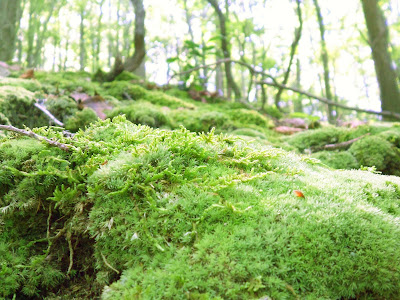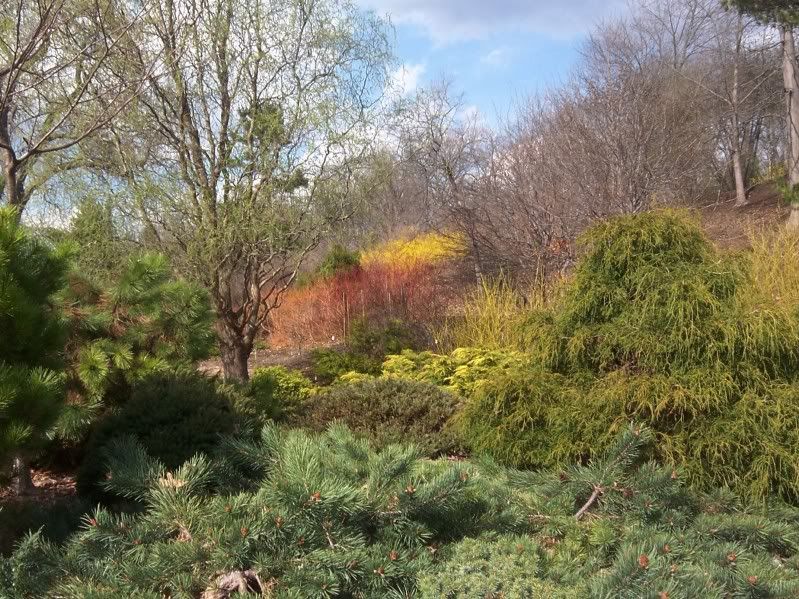I have recently come to the realization that once you find your true calling in life, opportunities will fall at your feet. It has been almost comical how many people and opportunities I have run into these past few months while venturing through my life on this moss-covered path. These events are reinforcing the universe’s plan for me, as if it whispering (or shouting) “Yes, Stephanie, you are on the right track, keep going” and with each subsequent experience I gain motivation and encouragement.
 Robin standing above a stone inlaid with salamander carving explaining how not only does the carving provide the perfect microclimate, but also because mosses are considered the amphibians of the plant kingdom
Robin standing above a stone inlaid with salamander carving explaining how not only does the carving provide the perfect microclimate, but also because mosses are considered the amphibians of the plant kingdomEarlier this month I attended a moss workshop hosted by Moss Acres in Honesdale, Pennsylvania. I was especially excited to attend this workshop because Robin Kimmerer was going to be a guest speaker and, well, we had so many things to discuss! The small group consisted mostly of landscape architects, designers and gardeners – okay, all except me. In the introduction it seemed apparent that most were there to learn how to grow moss in gardens…fast. This made me nervous. Moss is not speedy by any means, and I was afraid everyone would walk away with the notion that there is no such thing as instant moss gardens and to just give up on the idea or be prepared to deplete the local forest of its moss reserves. But these fears were put at ease as the day went on.
Al Benner gave some background on the property and their business (began by his father, David Benner) then Robin began with a little background on the evolutionary history of mosses. She reminded me of something fascinating: due to its derivation from bottom-of-the-sea dwelling algae, moss has retained its adaptation to photosynthesize at very low light levels (think not much light reaches the bottom of the ocean). That’s why it flourishes in the shady forest and underneath a thick blanket of snow. In fact there is a moss thriving happily at the bottom of Crater Lake, Oregon (over 1900 feet – the deepest lake in the US). One of the things I love the most about Robin’s approach to teaching mosses is to never forget their beauty, both within its simple physiological processes as well as the aesthetics it provides on a larger scale. Robin describes moss as “time made visible”. That is one of its greatest attributes, its ability to alter our human minds to perceive “old age” when seeing it blanketing its substrate.
 Al Benner standing on their green roof
Al Benner standing on their green roofThe staff proudly showed us their green roof experiment on top of a spring pump house. It looked great! I’ve been trying to advocate for the use of mosses on green roofs: they are very drought tolerant, and require a lot less substrate. They had inoculated the roof aggregate with
Hypnum imponens 2 years ago and it was taking off great. This past spring, however
Thuidium delicatulum took over and spread like wildfire, completely out-competing the
Hypnum.
Thuidium is well known as a “volunteer” species, but we weren’t complaining. In the near future they want to construct a sun-loving-moss green roof. Al took us to a sunny rock he found that had a few species growing on it and asked for their identities and if these were good roof candidates. There was
Hedwigia ciliata (always found on roofs)
Bryum argenteum and
Cetatodon purpurea – all wonderful selections for a sunny roof! Those species would create a beautiful mosaic of color and texture on a rooftop.
 Beech Grove
Beech GroveOur group moss-planting project ended up really being an exercise in understanding the “natural destiny” of an ecosystem: alter it any way you want, it will always want to revert back to its original state (though the extent of its originality that returns will vary). We were taken to a little beech grove at the edge of a forest with a large boulder perched to view the valley below. Immediately the group began ripping out some of the invasive vegetation and sweeping off the leaf litter from the boulder. A few of us stood back and watched a little confused as to what we were trying to accomplish here. Those who jumped in couldn’t help not noticing that the instant effects they were trying to gain by removing the vegetation and debris would only increase the erosion and wind potential in that area. All that exposed, rich humus beneath that leaf litter on the boulder would be washed away instantly. Those of us who stood back encouraged Robin to speak up: The reason why it accumulated there in the first place was because of the slope and location of that rock – its natural destiny is to accumulate leaf litter – a destiny that does not include moss (it cannot survive being smothered by debris). So creating a moss garden on that rock would only be possible if there was maintenance in removing the debris and keeping it moist (there would be water loss due to the slope of the rock). I explained that a moss garden would be possible, but it would require a lot less work on your part if you work with the natural tendencies of that ecosystem rather than fight against it. I mean, the reason why it was chosen in the first place was because it was already a special and beautiful spot; why change it?
 Al exhibiting the difference in moss growth using the “milkshake method” under a biodegradable film compared to no cover (the uncovered experiment is to the left of that mossy patch
Al exhibiting the difference in moss growth using the “milkshake method” under a biodegradable film compared to no cover (the uncovered experiment is to the left of that mossy patch The workshop introduced ideas of “tricking” the moss into growing at a faster rate. This is what put me at ease when I feared that the attendants would not learn that moss can grow relatively fast. I already put these conditions into practice at the private estate I worked at, and shared my successful experience (Side note: I discovered this private estate was the very same one Robin wrote a chapter on in her book, I took that shared experience as another reinforcing link between us Bryophiles, really what are the odds?). I might disclose these “tricks” later on (this post is long enough), but I will say that is it just a matter of lengthening that normally short period of time when mosses can actively grow.
I loved getting to chance to sit down with Robin and the other attendants over a nice hot bowl of delicious lamb stew and talk moss. I brought up some ideas I’ve been contemplating in tackling the issues associated with curating mosses in public gardens (which happens to be the focus of my thesis). I was commend on my ideas and got great new ones. Robin also expressed her desire to create a moss field guide book and in passing I offered up my services if she needed any help, and with intense sincerity and seriousness in her face and voice she said, “Stephanie, I would love for you to help.” I was surprised and elated by her invitation, and still very excited at the prospect of helping develop a field guide to mosses: another great future opportunity!
 Robin teaching us the ecological implications of preserving mosses in their natural habitats and other roles mosses play in nature
Robin teaching us the ecological implications of preserving mosses in their natural habitats and other roles mosses play in natureI was also happy to be proven correct in my hypothesis that the idea that mosses like acidic environments is not just because they like low pH, but because in very acidic soils many of the essential nutrients are not available to vascular plants, and therefore cannot grow there. Since mosses don’t acquire their nutrition from soil, they will happily just take over the spot that the vascular plants can’t. I’m not sure how widely known this idea is already, but I was just happy to be able to independently link these two occurrences together for my own little “a-ha” moment.
Another hopeful future goal is to develop ways to propagate mosses in a nursery setting – Robin and I agree that wild collection, however “sustainably” the collectors are gathering, is not the way to go. Those essential growing conditions would not be difficult to control, and I’m not aware of anyone who has tried.
This was such an amazing opportunity to learn, teach and network. It certainly won’t be the last time they see me! There is still so much work that needs to be done to bridge the gap between mosses and the public, it will certainly keep me busy for years to come, it is my destiny after all.
 Robin Kimmerer and Cathy Cope
Robin Kimmerer and Cathy Cope


 Dendroid: Rhodobryum roseum
Dendroid: Rhodobryum roseum











































